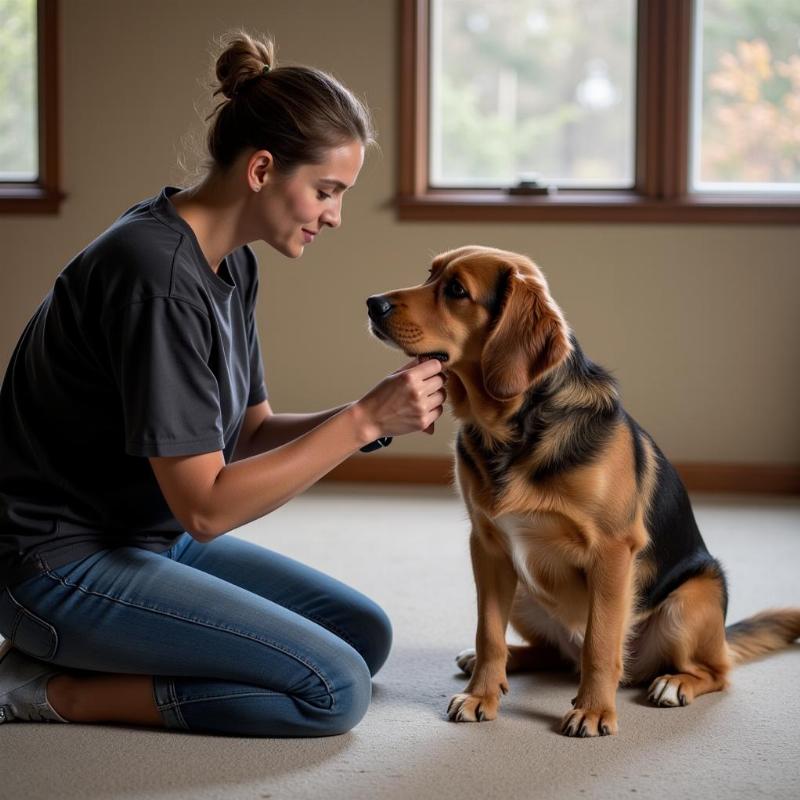A scared dog can be a heartbreaking sight. Whether it’s a stray, a newly adopted rescue, or even your own furry friend suddenly spooked by something unfamiliar, knowing how to coax a frightened dog to you is a valuable skill. This article will provide you with proven, effective strategies to earn the trust of a scared dog and help them feel safe enough to approach you.
Understanding a Scared Dog’s Body Language
Before attempting to approach a scared dog, it’s crucial to understand their body language. A tucked tail, flattened ears, averted gaze, and trembling are all signs of fear. The dog may also pant heavily, whine, yawn excessively, or even lick their lips – all subtle signs of stress. Recognizing these cues will help you gauge the dog’s level of fear and adjust your approach accordingly.
What should you avoid? Sudden movements, direct eye contact, and reaching out directly towards the dog can be perceived as threatening. Instead, try squatting down to their level, turning your body slightly to the side, and avoiding direct eye contact. Speak softly and gently, using a calming tone.
Creating a Safe and Inviting Environment
A scared dog needs to feel safe before it will approach you. Creating a calming environment is key to building trust. If possible, move the dog to a quiet, enclosed area free from distractions. If the dog is outdoors, try to create a temporary safe space using a blanket or a jacket. Avoid overwhelming the dog with attention. Patience is crucial.
Offer something enticing, like high-value treats such as small pieces of cooked chicken or cheese. Toss the treats gently towards the dog, starting at a distance, gradually decreasing the distance as the dog begins to approach. Don’t force interaction. Let the dog come to you on their own terms.
Using Positive Reinforcement to Build Trust
Positive reinforcement is a powerful tool for building trust with a scared dog. Once the dog starts taking treats from you, continue to reward them with gentle praise and more treats. Keep your movements slow and deliberate, avoiding anything that might startle them. Over time, the dog will associate you with positive experiences, making them more likely to approach you in the future.
What if the Dog is Still Too Scared to Approach?
If the dog remains too scared to approach, don’t give up. Patience is key. Continue to create a positive and inviting environment. You can also try sitting quietly nearby, reading aloud, or speaking softly to the dog without making direct eye contact. The sound of your voice can be calming.
If the dog is a stray or appears injured, contact your local animal control or rescue organization. They have experience handling scared dogs and can provide the necessary assistance.
Seeking Professional Help
Sometimes, a scared dog may require professional help. A certified professional dog trainer or veterinary behaviorist can assess the dog’s behavior and develop a tailored plan to help them overcome their fear. They can also provide guidance on how to manage the dog’s fear in specific situations.
 Professional Dog Trainer Working with Scared Dog
Professional Dog Trainer Working with Scared Dog
Conclusion
Getting a scared dog to come to you requires patience, understanding, and a gentle approach. By creating a safe environment, using positive reinforcement, and avoiding threatening behaviors, you can build trust and help the dog feel comfortable enough to approach. Remember, earning a scared dog’s trust takes time and effort, but the rewards are immeasurable.
FAQ
-
What should I do if a scared dog growls at me? Do not approach. Back away slowly and give the dog space. Contact animal control or a rescue organization if the dog is a stray.
-
Can I use toys to lure a scared dog? Yes, you can try using toys, but start by tossing them gently towards the dog, avoiding throwing them directly at them.
-
How long does it take for a scared dog to trust you? It varies depending on the dog’s individual history and temperament. It can take days, weeks, or even months.
-
Should I force a scared dog to interact with me? Never force interaction. Let the dog come to you on their own terms.
-
What if the scared dog is injured? Contact animal control or a rescue organization immediately. Do not attempt to handle an injured dog yourself.
-
My own dog is suddenly scared. What should I do? Create a safe space for your dog and try to identify what might have frightened them. If their fear persists, consult with your veterinarian.
-
Is it okay to pet a scared dog? Only pet a scared dog if they approach you and show signs of wanting to be petted. Avoid reaching over their head or touching their face.
“Patience and understanding are key when working with a fearful dog. Building trust takes time, but it’s the foundation for a strong and loving relationship.” – Dr. Emily Carter, Certified Veterinary Behaviorist
“Never underestimate the power of positive reinforcement. Even small rewards can make a big difference in helping a scared dog overcome their fear.” – Mark Johnson, Certified Professional Dog Trainer
Related Articles on Beautdogs.us
Beautdogs.us is your premier resource for all things dog-related in the US. We offer expert advice on dog breeds, care, training, and product reviews. Whether you’re a new dog owner or a seasoned pro, Beautdogs.us provides trusted, comprehensive, and engaging information to enhance your dog’s life and deepen your bond. Contact us today for expert guidance! Email: [email protected], Phone: +1 501-555-7529. Connect with Beautdogs.us for all your canine needs.